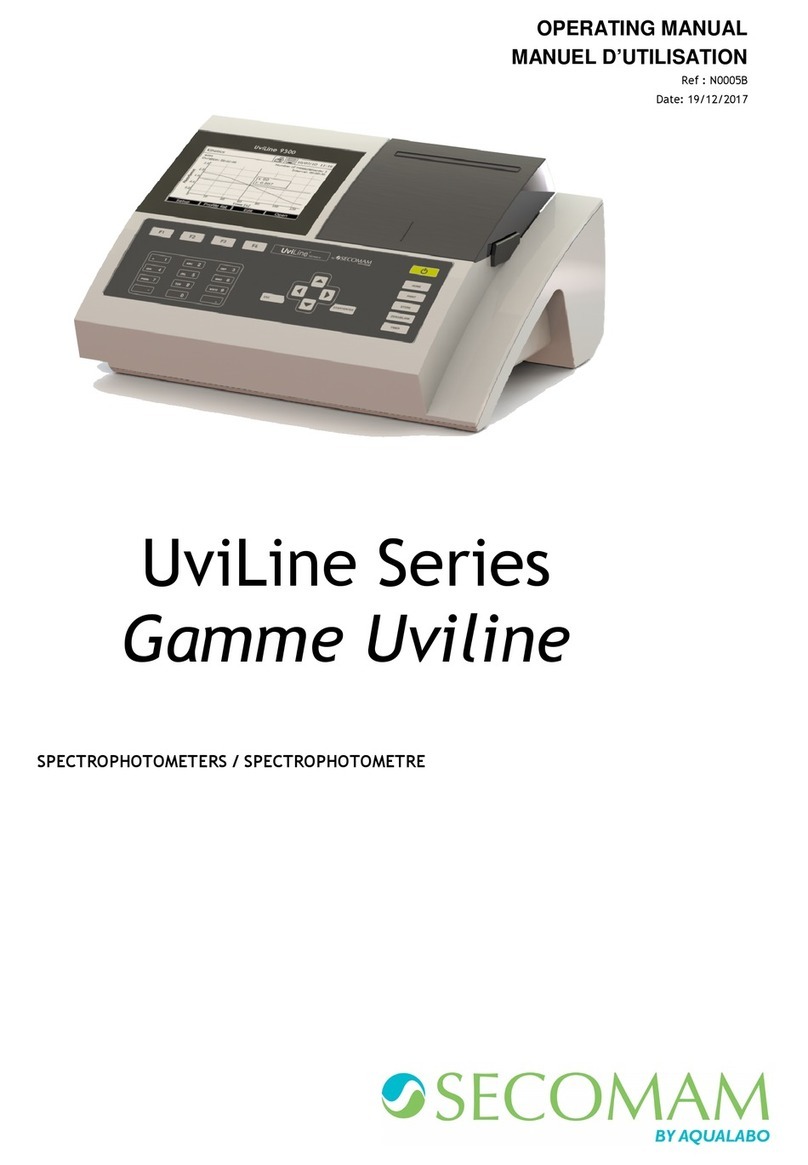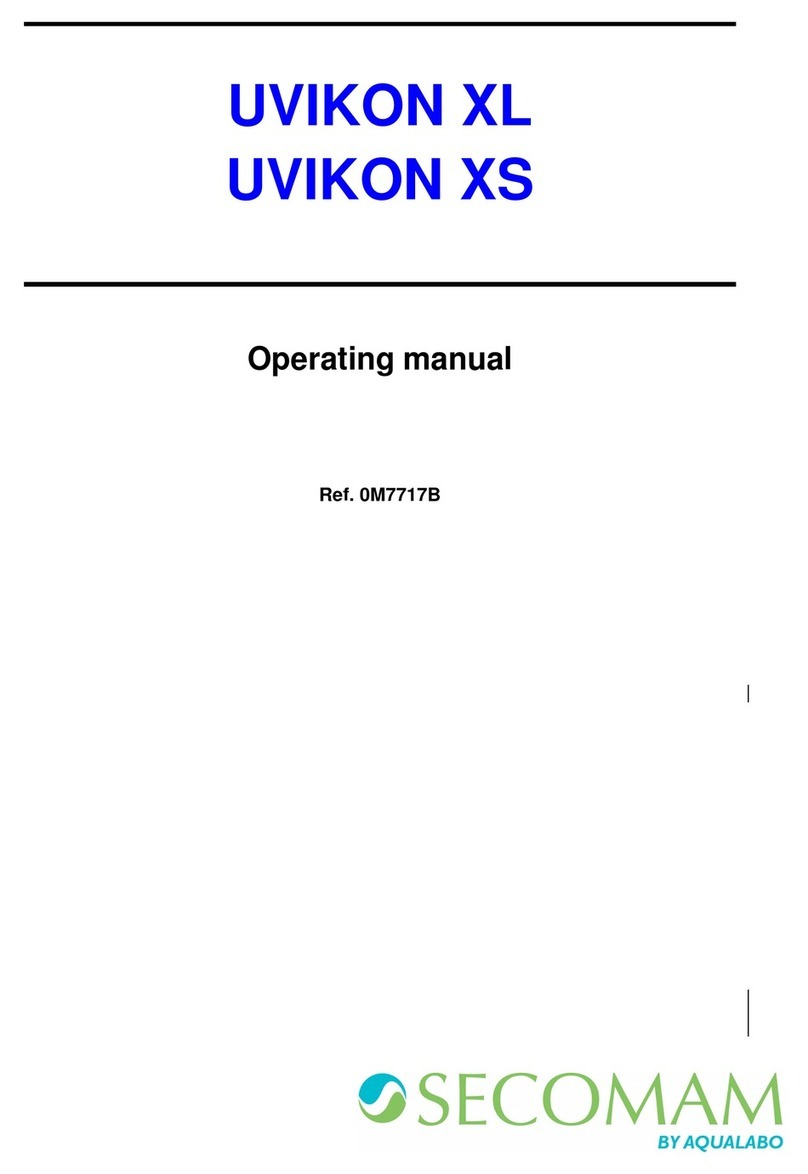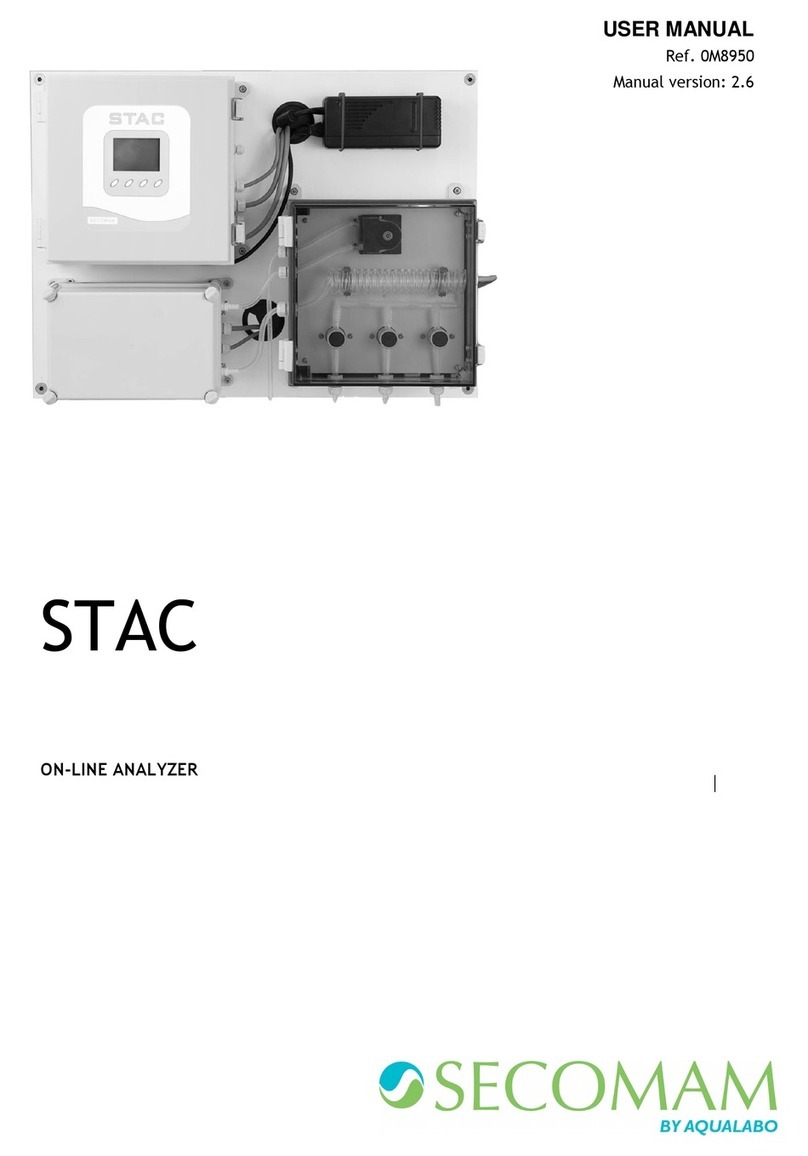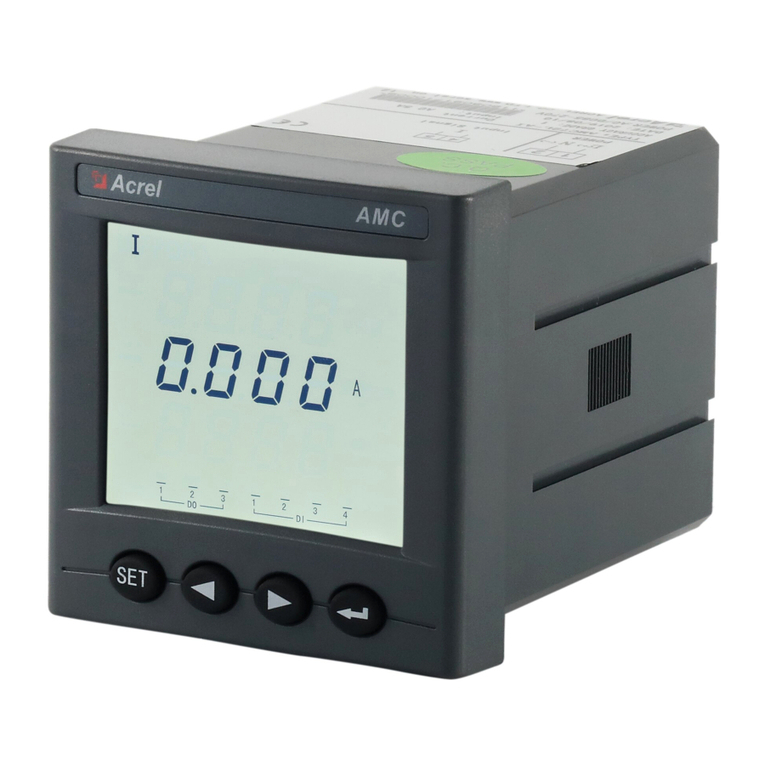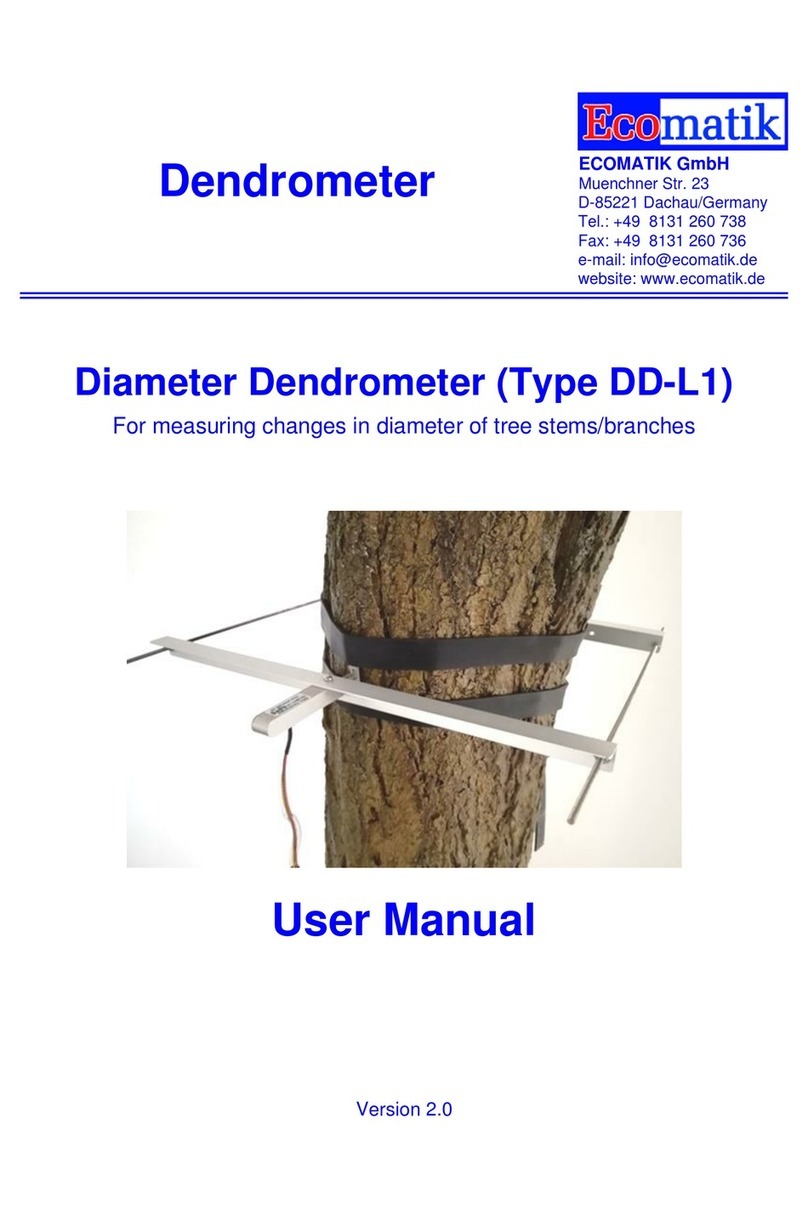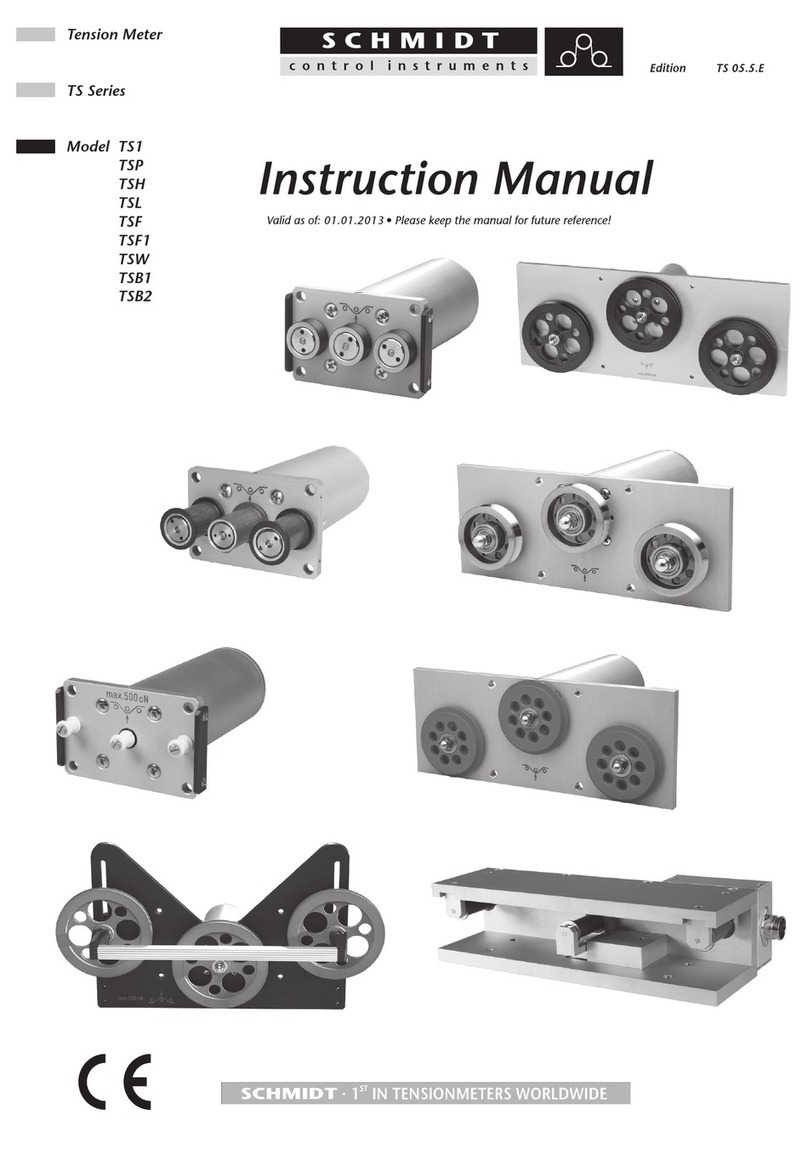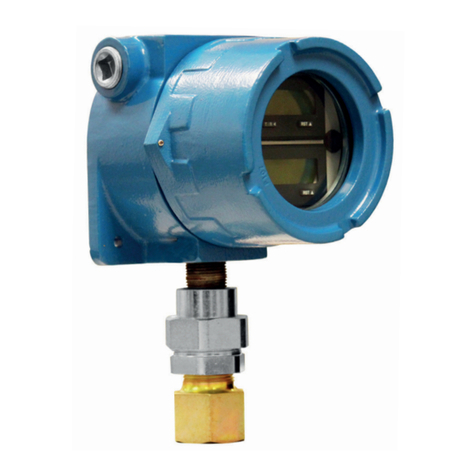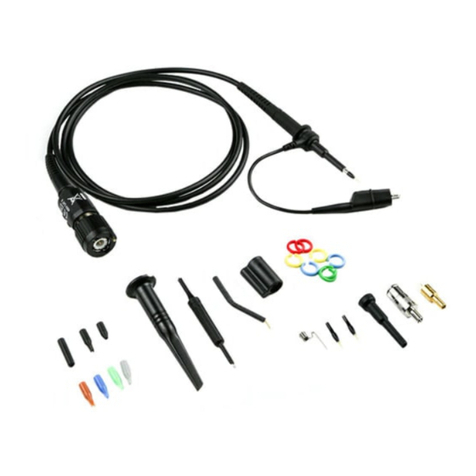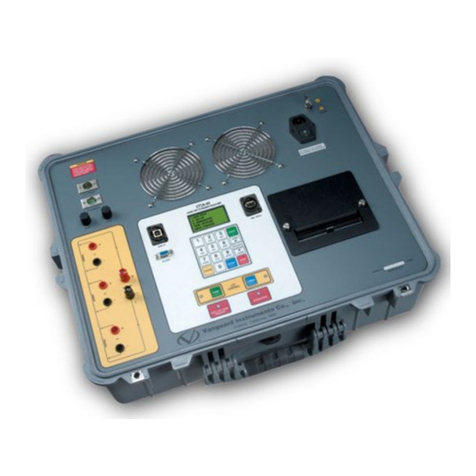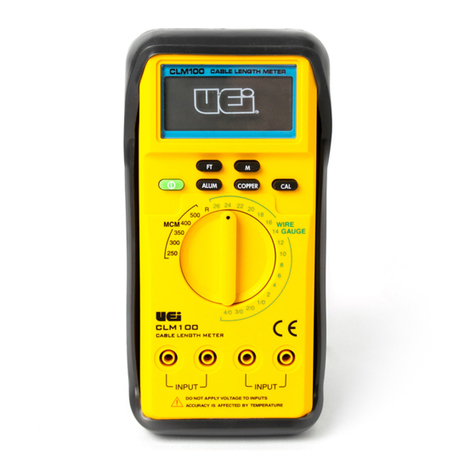Secomam Basic User manual

USER’S MANUAL
Ref. 0NVBAU-F
BASIC
PHOTOMETER


BASIC
- 3 -
SUMMARY
1.
REMARKS.................................................................................................................................................... 5
2.
WARRANTY................................................................................................................................................. 7
3.
INFORMATION........................................................................................................................................... 9
4.
PRECAUTIONS OF USE.......................................................................................................................... 11
5.
PRELUDE ................................................................................................................................................... 13
6.
DESCRIPTION........................................................................................................................................... 15
6.1.
G
ENERAL OVERVIEW
............................................................................................................................. 15
6.2.
S
CREEN AND KEYBOARD
........................................................................................................................ 15
6.3.
D
ISPLAY DESIGN
.................................................................................................................................... 17
6.4.
FLUID
CIRCUIT
DESCRIPTION........................................................................................................ 18
7.
PARAMETERS SETTING........................................................................................................................ 19
7.1.
G
ENERAL
CONFIGURATION.............................................................................................................. 19
7.2.
LANGUAGE SET
-
UP
................................................................................................................................. 20
7.3.
D
ATE AND CLOCK SET
-
UP
...................................................................................................................... 21
7.4.
PUMP SET
-
UP
.......................................................................................................................................... 21
7.4.1.
Pump rate (calibration)................................................................................................................. 22
7.4.2.
Delay............................................................................................................................................. 22
7.4.3.
Dead volume.................................................................................................................................. 23
7.5.
PRINTER SET
-
UP
..................................................................................................................................... 23
7.6.
T
RACEABILITY SET
-
UP
........................................................................................................................... 25
7.7.
DATA
EXPORT ................................................................................................................................... 26
7.7.1.
On computer.................................................................................................................................. 26
7.7.2.
On printer...................................................................................................................................... 27
7.7.3.
Memory initialization.................................................................................................................... 27
7.7.4.
Kinetic report................................................................................................................................ 27
7.8.
QUALITY CONTROL SET
-
UP
..................................................................................................................... 28
8.
PROGRAMMING & MEASUREMENT ................................................................................................. 33
8.1.
P
ROGRAM KEYS
..................................................................................................................................... 33
8.2.
ANALYSIS
NAME
PROGRAMMING ............................................................................................... 34
8.3.
ASPIRATION
VOLUME
PROGRAMMING...................................................................................... 34
8.4.
TEMPERATURE
PROGRAMMING................................................................................................... 34
8.5.
UNITS
PROGRAMMING.................................................................................................................... 35
8.6.
RESULTS
RESOLUTION
(
DECIMALS
)
PROGRAMMING................................................................. 35
8.7.
CALCULATION
MODE
PROGRAMMING....................................................................................... 35
8.8.
WAVELENGTH
PROGRAMMING.................................................................................................... 37
8.9.
ANALYSIS
MODE
PROGRAMMING ............................................................................................... 37
8.10.
LINEARITY
LIMIT
PROGRAMMING........................................................................................... 40
8.11.
NORMAL
HIGH
AND
LOW
PROGRAMMING ............................................................................ 40
8.12.
QUALITY
CONTROL
FREQUENCY
PROGRAMMING.............................................................. 40
8.13.
MEASURE........................................................................................................................................ 41
8.14.
MULTI-STANDARDS
CALIBRATION......................................................................................... 42
8.15.
E
RROR MESSAGES
.............................................................................................................................. 44
8.16.
PATIENT
REPORT
AND
PRINT
OUT ........................................................................................... 46
8.17.
S
AMPLE NUMBERING
.......................................................................................................................... 47

BASIC
- 4 -
9.
MAINTENANCE........................................................................................................................................ 49
9.1.
LAMP
CHANGING.............................................................................................................................. 49
9.1.1.
Warning......................................................................................................................................... 49
9.1.2.
Lamp checking .............................................................................................................................. 49
9.1.3.
Halogen lamp changing................................................................................................................ 49
9.2.
BATTERY
REPLACING..................................................................................................................... 51
9.3.
PERISTALTIC
PUMP
HEAD
REPLACING....................................................................................... 52

BASIC
- 5 -
1.
REMARKS
The Automatic aspiration system kit is manufactured by AQUALABO ANALYSE.
The information contained in this document may be the object of patents or patent applications by
AQUALABO ANALYSE. The possession of this document does not confer any license to such patents.
The following names are AQUALABO ANALYSE’s registered trademarks throughout the world.
SECOMAM
BASIC
This manual is updated periodically. The updates are included in the new editions.
All information supplied in this edition of the manual may be amended before the products described
herein are available.
All reproduction rights reserved.


BASIC
- 7 -
2.
WARRANTY
The new equipment and material sold by AQUALABO ANALYSE is guaranteed against any
manufacturing defects for 3 years (unless otherwise stated by AQUALABO ANALYSE) with effect:
−From the technical acceptance of the equipment in the factory by the buyer or his designee,
−or failing this :
* For Metropolitan France: from the date on the delivery note.
* For other destinations: from the date of factory shipment certified by air waybill,
consignment note or bill of lading.
The AQUALABO ANALYSE company guarantee applies exclusively to defectiveness arising from a
design fault or from a concealed defect. It is strictly limited to the free dispatching of replacement parts
(except for consumable items) or to the repairing of the equipment in our workshops within a deadline
of 10 working days (shipping delay not included).
By express agreement, the following are strictly excluded from our guarantee:
−All damages, notably for staff costs, loss of earnings, business trouble, etc.
−Any breakdown due to an incorrect use of the equipment (non adapted mains, fall, attempt at
transformation, etc) or to a lack of maintenance by the user or to poor storage conditions.
−Any breakdown due to the use of parts not supplied by AQUALABO ANALYSE, on AQUALABO
ANALYSE equipment
−Any breakdown due to the transporting of the equipment in packaging which is not its original
packaging
−The lamps, the cells and generally any item which appears in the "accessories" section on the
price list.
Our customers are kindly asked to apply for our consent before returning any instrument for repair. No
return of materials may be accepted without the prior written consent of our Sales Management which
will precise the terms of such return.
If the above consent is given, articles shall be returned in their original packaging on a prepaid basis to
the following address:
AQUALABO ANALYSE - SECOMAM - 91 avenue des Pins d’Alep – 30100 ALES FRANCE
We reserve the right to reship all instruments received collect failing such consent.
Whatever method and conditions of transport are chosen for the shipment of the equipment to be
repaired under guarantee, in the original packaging, the corresponding costs and the insurance costs
will be payable by the customer.
Any damage connected to the return transport of the equipment falls within the framework of the
guarantee on the express condition that the customer has sent his complaint within forty-eight hours
by registered letter with acknowledgement of receipt to the carrier. A copy of the letter should be sent
to AQUALABO ANALYSE.
For equipment with a guaranty card, this is only applicable if the card delivered with the equipment is
returned to AQUALABO ANALYSE duly completed.

BASIC
- 8 -
SOFTWARE GUARANTEE
The software is guaranteed by the designer or the distributor of the software under the conditions
specified in the literature accompanying the aforementioned software packages.
Under no circumstances whatsoever will AQUALABO ANALYSE supply any type of guarantee for
software packages.
By express agreement, all damages, notably for staff costs, lost of earnings; business trouble, etc are
strictly excluded from our guarantee.
The customer is informed that the software cannot be guaranteed exempt from defects or bugs.
TRADE SECRET AND PROPERTY RIGHTS
This document is protected by a AQUALABO ANALYSE copyright (c) 2003 and the copying rights are
explicitly reserved. The software supplied with the equipment or referenced contains trade secrets and
confidential information which are AQUALABO ANALYSE's property. It is legally protected by the
international copyright (c) laws.
AQUALABO ANALYSE grants a license to use its software to the user. This may not be disclosed,
used or duplicated with the intention to save it, without AQUALABO ANALYSE's written permission.
The beneficiary must attach a copy of this document to all authorized partial or total reproductions.

BASIC
- 9 -
3.
INFORMATION
The AQUALABO ANALYSE equipment has been designed, manufactured, tested and inspected
according to the ISO 9001 standards.
If the unit is not immediately installed, it should be stored in a dry and clean area. The storage
temperature should be between 10 and 35°C.
AQUALABO ANALYSE equipment is carefully inspected before it is packed. As soon as you receive
your equipment, check the condition of the packaging and if you notice any problems, notify your
carrier within 48 hours. Then consult the packing list and check that everything is in order. Finally, if
you discover that something is missing, or if the goods are damaged immediately notify AQUALABO
ANALYSE.


BASIC
- 11 -
4.
PRECAUTIONS OF USE
Always make sure that the instrument is connected on the good voltage.
(Between 100 – 240V 50-60Hz)
Always disconnect the mains plug before starting any work inside the
instrument.
When dangerous substances for health and environment are used, the
laboratory or site rules, where the instrument is installed must be
followed.
Take all the necessary precautions, during the use the instrument, to
protect the operator from eventual liquids leaks or spills or possible
radiations (protective gloves, glasses , protected clothes, etc)
All operations made inside the instrument, must be done by AQUALABO
ANALYSE or by AQUALABO ANALYSE’s authorized technicians.
Use of the spectrophotometer without danger
If it is necessary to suppose that it is not possible any more to use the
spectrophotometer without danger, it is necessary to put it out of service
and to protect it from involuntary starting up again.
Use without danger will not be possible when the spectrophotometer
•suffered damage during transportation.
•was stored under inadequate conditions for one relatively long
period
•present some visible damages.
•does not function any more as described in the user’s manual.
In case of doubt, consult the spectrophotometer supplier.


BASIC
- 13 -
5.
PRELUDE
The BASIC was designed within the framework of In Vitro Diagnostic to cover the need of semi-
automatization in clinical biochemistry analysis.
It includes the principal functions required by this kind of analysis such as:
Wavelength range 340-700 nm,
Peltier thermostated cell holder
Calculation method adapted to substrate reading and enzyme kinetics.
Quality control management
Partial management of laboratory practice
BASIC complies with the requirements in CE marking of medical devices for In Vitro Diagnostics
(98/79/EEC)


BASIC
- 15 -
6.
DESCRIPTION
6.1.
GENERAL OVERVIEW
Front view:
1 Program keys + number keys.
2 Control keys.
3 Screen.
4 Function keys.
5 Cursors.
6.2.
SCREEN AND KEYBOARD
Function and screen keys
:
Thanks to these keys, working
with BAS
IC is simplified. Screen
instructions as well as the
function keys guide you
throughout the analysis.
On the display, Function keys
correspond to an icon or a value.
Simply validate by a light stroke.

BASIC
- 16 -
Program keys: each program key can contain two test methods: on the primary position (noticed in
white color) and the secondary position (secondary position are M1 to M47). These program keys are
preassigned to give you an idea of the program capacity and calculation method the instrument is
capable of. You can modify any given test method at any time, experiment your own parameters,
place it at a different key than the original and call it just by one stroke. Before modifying, it is
recommended to print the existing test method.
Number keys: It is included in the selection keyboard and is activated automatically when a value is to
be specified (date, hour, programming values,…)
•
Cursor keys
: Use these keys to have access to
other functions of the keyboard such as :
-elevator movement
: BASIC test
methods on the primary and
secondary positions, next screen
display,
-right arrow for double rinse

BASIC
- 17 -
BASIC’s software control keys:
6.3.
DISPLAY DESIGN
When using a standard cuvette, this cuvette is shown on the screen:
When the peristaltic pump is used, the screen represents the tube with the sample:
Erase & correct data
Reach software configuration screen
Quit active screen
Validate an operation
Programmed
temperature Calculating method
Concentration value,
measuring unit
Absorbance value
(blank value
deducted)
Test name
Name of sample measured
(standard, sample X ...)

BASIC
- 18 -
6.4.
FLUID CIRCUIT DESCRIPTION
1– GUIDE FOR SUCTION TUBE
3– PERISTALTIC PUMP
2– FLOWTHROUGH CUVETTE REF: 0GG174Z8.5
REF 80VB0380

BASIC
- 19 -
7.
PARAMETERS SETTING
7.1.
GENERAL CONFIGURATION
The instrument configuration is carried out using the function key « CONF ».
CLOCK

BASIC
- 20 -
N
NOTE: CONFIGURATION screen is active when you see an
elevator in the middle of the screen. Use upward and downward
cursor keys to activate and have access to the next display
screen.
7.2.
LANGUAGE SET-UP
This would be the first configuration to check upon starting the instrument. Successively press
« CONF », « downward cursor key », (F1) « Language set-up » then (F3) « English ».
Access to the menu which
allows modifying
parameters
of original analysis.
Access to pump
set
-
up menu
PUMP
QUALITY CONTROL
Confirm (F1) or skipping (F4) the
quality control function. Display (F3)
values and dates of previous control.
PROGRAM
Table of contents
Other Secomam Measuring Instrument manuals
Popular Measuring Instrument manuals by other brands
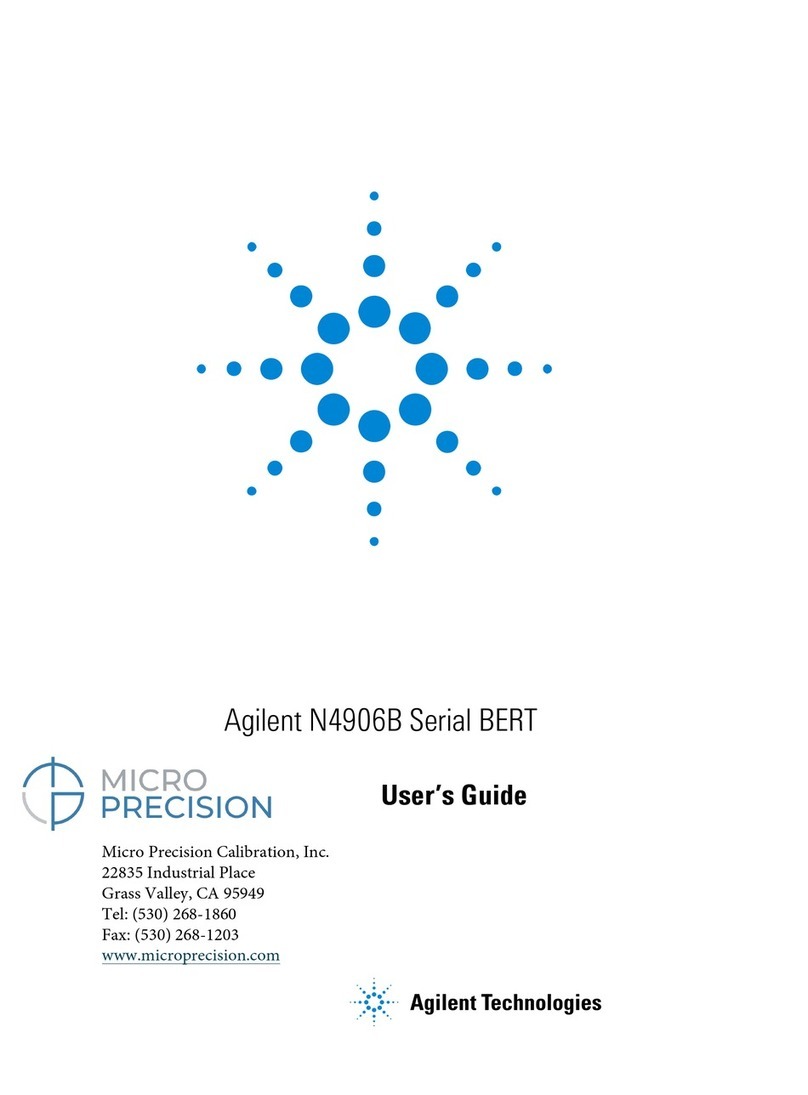
Agilent Technologies
Agilent Technologies N4906B Serial BERT user guide

Rion
Rion NA-28 instruction manual
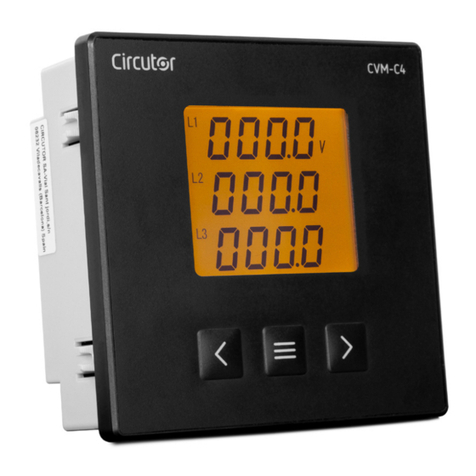
Circutor
Circutor CVM-C4 Series instruction manual
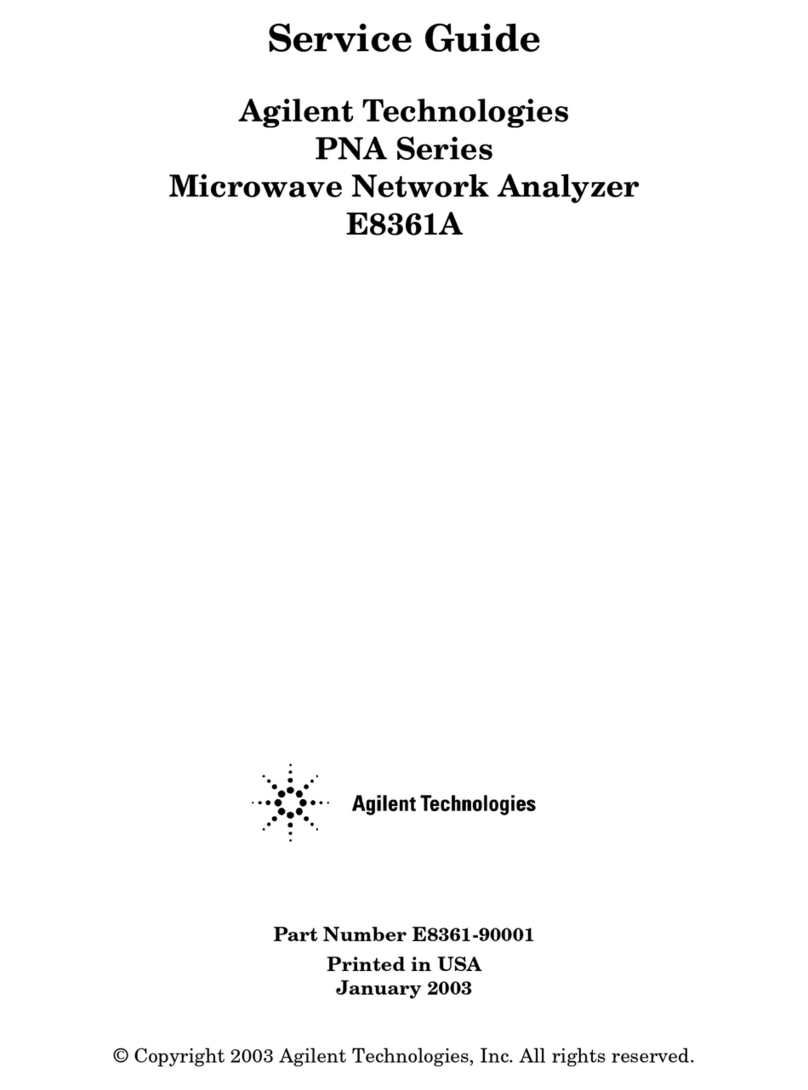
Agilent Technologies
Agilent Technologies PNA Series Service guide

Spirax Sarco
Spirax Sarco STAPs Quick installation guide
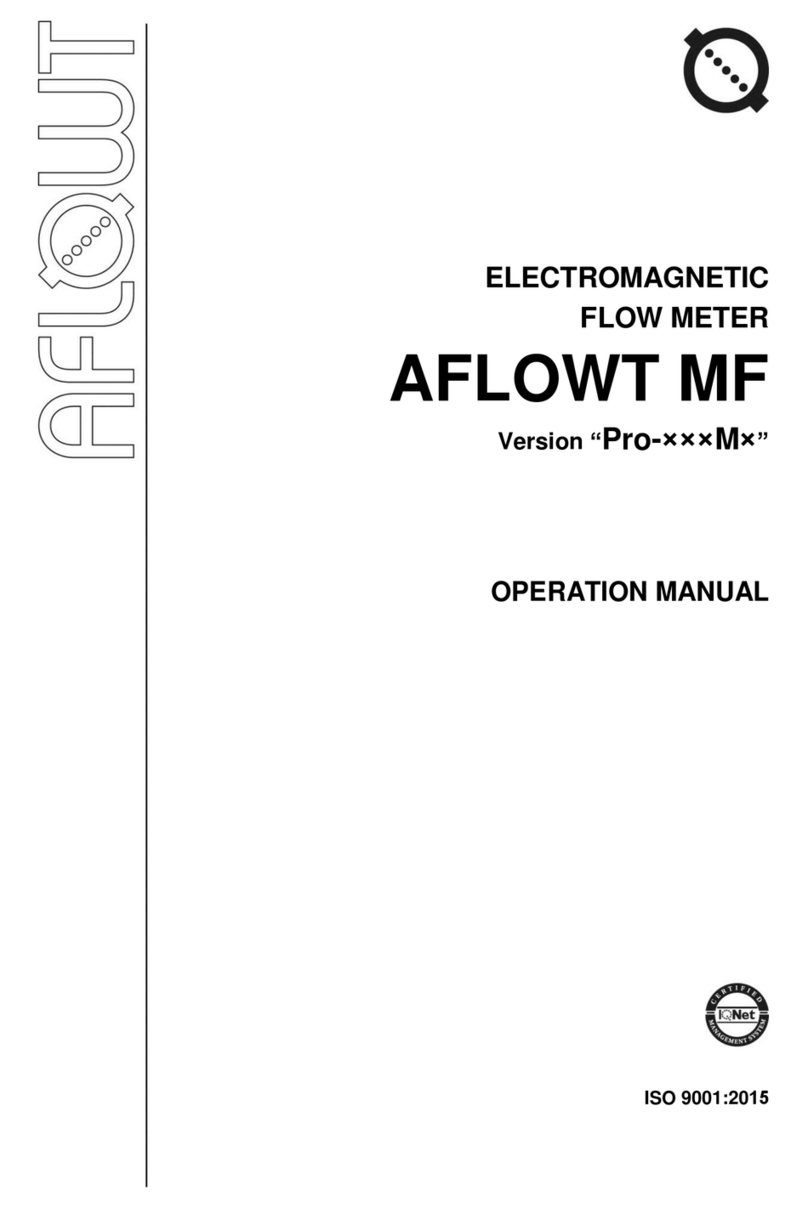
AFLOWT
AFLOWT MT Pro M Series Operation manual
